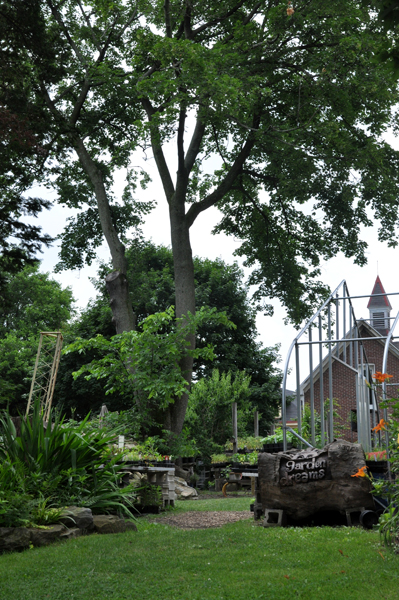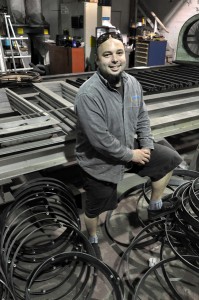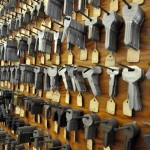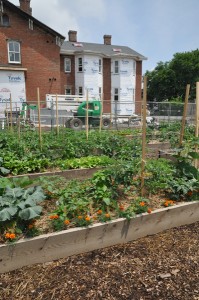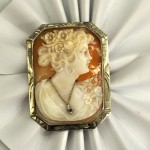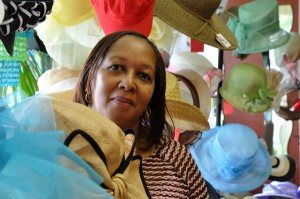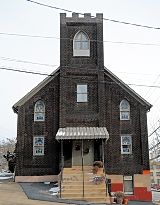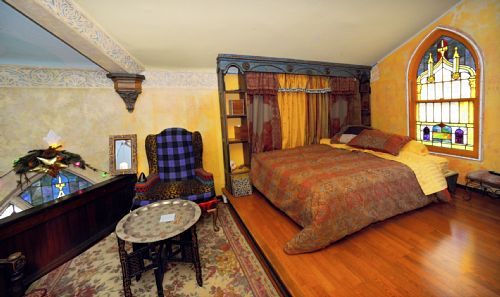
Category Archive: Pittsburgh Post-Gazette
-
The Insider Guide to Wilkinsburg
Anne Caffee | Wednesday, July 27, 2011Many in Wilkinsburg credit the Wilkinsburg Community Development Corporation for helping to drive this spirit of optimism. The WCDC was organized in 2007 to attract investors and entrepreneurs to its main commercial district on Penn Avenue.Its energetic and tenacious executive director, Tracey Evans, knows that Wilkinsburg’s success will be built brick by brick. “We are working hard to lay the right foundation for a more successful business district,” she says.Evans, a 25-year resident of Wilkinsburg, is in her fifth year as an elected member of the borough council, and chairs the Wilkinsburg Municipal Authority and Wilkinsburg Borough Commercial and Industrial Development Authority. She started out as a freelance set designer for Pittsburgh stage productions, and got involved as a volunteer in a number of local restoration projects. A graduate of Point Park University, her career in community revitalization took flight when she became the first executive director of the Wilkinsburg Community Development Corporation, which she helped found.
Now, in addition to overseeing the execution of a 6-year $1.8 million Neighborhood Partnership Plan for Wilkinsburg, funded by Tri-State Capital Bank and the Pennsylvania Department of Community and Economic Development, and developed with input from the borough, residents, and the business community, the WCDC is deep in the first phases of Streetscape Improvement Program to revamp the Penn Avenue corridor.
The first phase of the Program’s investment has provided tree pruning, 80 decorative streetscape banners, and locally fabricated trash receptacles designed by Technique Architectural Products, whose owner, Ray Appleby, is a CMU-trained sculptor. (His shop has outfitted Mad Mex locations with some cool metal work).
A recent grant through TreeVitalize Pittsburgh and the Borough of Wilkinsburg will put in place 500 new street trees, all to be planted by Nine Mile Run Watershed Association and volunteers on public property. A grant from Duquesne Light helped refurbish existing streetlights and create a well-lit and safer corridor while the Wilkinsburg Police Department has re-established a walking police presence along the business district.
“Our primary focus is crime and safety issues,” states Evans, “along with enforcement of building codes, loitering and littering laws. Our beautification work will also help attract business and investment back to Wilkinsburg.”
Some of Wilkinsburg’s old and architecturally gifted homes in the Hamnett Place neighborhood have been restored through the efforts of the Pittsburgh History and Landmarks Foundation (PHLF). Their Wilkinsburg redevelopment projects have successfully restored four homes in the Hamnett Place neighborhood; work on three more historic homes, and the two-building, 27-unit Crescent Apartment development, are scheduled for completion by the end of this year.
PHLF launched a housing resource center, and has cleaned and cleared vacant lots, “Initiatives taking place right now in Wilkinsburg total over $10 million,” says Michael Sriprasert, PHLF director of real estate.
Urban Homesteading: finding your match
For the socially progressive, frugal and urban-focused homeowner not afraid to get his/her hands dirty, Wilkinsburg is the right match: racially/ethnically diverse, close to the city and fuel-efficient: eight-minutes’ drive to downtown, close to urban programs and amenities and public transportation (access to the East Busway can get anyone downtown within 20 minutes) and within a fifteen-minute drive of four city neighborhoods, the Waterfront, and Monroeville.Wilkinsburg offers eye-poppingly affordable real estate for urban homesteaders and entrepreneurs who can spot an architectural gem beneath the overgrowth, and are willing to put in sweat equity to polish it up. (One business owner bought a parcel of land on a credit card).
Resident Chad Chalmers, an architect and member of the WCDC’s design committee,spotted a typical diamond-in-the-rough on an overgrown lot: six-bedroom, three-bath home with hardwood floors and 14 stained glass windows, which he and his wife Brigitte “fell in love with, and bought for a song,” and has spent five years restoring.
A new website provides up-to-date for rent/for sale listings in Wilkinsburg. The Borough and School District have developed a Tax Based Expansion Ordinance, which provides for tax compromise and tax abatement opportunities. Plenty of rehab and restoration programs stand ready to help homesteaders and investors who want in on the ground floor of an area poised for new growth.
But its biggest assets are long-standing businesses, some more than 30 years old, and a large number of robust and committed volunteers in its neighborhoods who care and dig in to run programs and restore neighborhoods.
Wilkinsburg Means Business
Downtown Wilkinsburg is five-block area along busy Penn Avenue (Pa. Route 8) and Wood Street that features unique businesses, residences, and historic and landmark architecture. What you won’t see are taverns and night clubs; Wilkinsburg has been legally dry since 1870. After the repeal of Prohibition in 1933 when liquor sales became a local option, residents voted to keep saloons out of Wilkinsburg. (Look for beer, tobacco, and soda, sold by the case on Penn Avenue’s Wilkinsburg Beverage Co.)
If you’re a fan of the Strip District, plan a visit to Pittsburgh Asian Market, a.k.a. Ou’s International, located on Penn Avenue, owned by Louis and Mai Ling Ou since 1981. Their large collection of specialty groceries and produce features hard-to-find items for Asian, Hispanic, and African-American menus.
Valley SalesValley Sales, a locksmith and key business on Penn Avenue in business since 1929, has an amazing wall display of hundreds of keys, both antique and modern. Owner Mary Blackburn remembers one customer who had just purchased a sweet 1967 Chevelle, and needed a key. She found one.
Matt’s Up-beat Records on Penn features current and hard-to-find soul, vintage Motown, hip hop, gospel, and jazz releases, along with DVDs and poster art.
Family-owned James Florist on Wood Street recently refurbished their store entrance and sign with a Pennsylvania “Main Street” façade grant. They’ve been providing posies for proms, weddings, funerals and family celebrations for more than a century. Step inside to see one of their favorite holiday store props: an antique horse-drawn sled in mint condition.Wilkinsburg has made a for itself in the urban farming/grow-your-own food movement with its new Hamnet Place Community Garden, leased to the community by PHLF (and each plot taken) and Garden Dreams, a certified organic farm and heirloom seed business.
Kenyon Jewlers, in business since 1924, is where the owner, Doug Duffus, does restoration on antique pieces, can custom create a wedding ring, and repair most anything brought in. In other words, he runs the place the way jewelry stores used to be run: with knowledgeable people and masters of their craft.
Leah Thomas opened a ladies’ boutique, A Woman’s Touch, on Penn Avenue seven years ago. Among fashionable church-going ladies in town, the sherbet-colored hats in her window never go out of style. This year, with a royal wedding spurring interest in stylish chapeaux, she had 150 to 200 new wholesale and custom-designed pieces on her racks. (*article in P-G:http://www.post-gazette.com/pg/11107/1139441-314.stm#ixzz1SIxp8woG*)Representative of Wilkinsburg’s historic pride in its churches, St. James Catholic Church, a gothic beauty almost 150 years old. has a long-standing commitment to social justice, and is a member of the Pittsburgh Interfaith Impact Network (it was one of its founding members), and is the only Wilkinsburg-based church among the PIIN membership.
To read more about Wilkinsburg businesses see the Featured Neighborhood on our home page this week and click on Live. Work. Play.Captions: Garden Dreams; Louis and Mai Ling Ou; Valley Sales; Community Garden; Kenyon Jewelers; Leah Thomas.
Photographs copyright Brian Cohen
-
Historic Designation Rejected for Civic Arena
Wednesday, March 02, 2011By Mark Belko, Pittsburgh Post-GazetteThe city Historic Review Commission refused to designate the Civic Arena a city historic structure today, a setback for those seeking to save the old building.
The panel voted 6-0 to reject the building’s nomination, reversing an earlier decision to designate the arena as a historic structure.
It followed the same pattern that occurred in the early 1990s when the commission gave preliminary approval and then rejected it in a final vote.
The decision is a setback for local preservationists who have been trying to stop the demolition of the 49-year-old arena. It is a victory for the Penguins, who want to use the site for housing, offices and shops.
Before he voted, Ernie Hogan, the commission’s acting chairman, said he did not think the arena met any of the 10 criteria for nomination.
Rob Pfaffmann, leader of Reuse the Igloo, said afterwards he was very disappointed with the decision but would continue the battle to save the structure.
The fight is far from over. The city planning commission and ultimately city council still must take up the nomination.
-
Fairview Park in Delmont Gains National Historic Status
Thursday, February 24, 2011By Laurie BaileyFairview Park in Delmont Gains National Historic Status
It’s important for retired history teacher Barbara Calloway that her children and grandchildren realize the impact of Salem Township’s Fairview Park on her own family and a generation of area African-Americans.
“They really can’t imagine the whole segregation thing. It’s part of our integrity, our history and part of who we are,” she said.
The park was selected earlier this month to be on the National Register of Historic Places. It was developed in 1945 by the Monongahela Valley Sunday School Association — a group of African-American churches from Westmoreland and Allegheny counties. At a time when segregation restricted access to other public amusement parks, Fairview Park was a place the African-American community could call its own.
“The designation is a recognition of what the people who founded the land had to go through,” Fairview Park Association president Ernest Jackson said.
The idea for a safe, welcoming place for African-American families, many from urban communities, to have fun and fellowship was actually conceived in 1918, Mr. Jackson said.
“No banks were lending money for land to black folks at that time,” he said. A banker himself, Mr. Jackson is vice president of operations for Dollar Bank.
People put up their own cash, even mortgaged their homes to develop the 100 acres of land where a roadside gas station and restaurant once stood along Route 22. “It wasn’t an easy transaction,” Mr. Jackson said.
By the 1940s and 1950s, the park established itself as the first African-American-owned amusement park and the place to go for church picnics and other gatherings. In its heyday, it featured a roller coaster and merry-go-round for small children, a swimming pool, softball fields, playground equipment, petting zoo and even hot air balloon rides.
“We took our picnic baskets and visited. The church picnic was the highlight of the year,” said Mrs. Calloway, of Point Breeze. Most churches had buses to transport those without cars to the Westmoreland County park.
“If you trace the history of the Civil Rights movement, you could determine when the park was most popular,” Mr. Jackson said.
Attendance started to decline in the late 1960s with the Civil Rights movement.
As money was needed throughout the park’s history, parts of the land were sold, including 33 plots that created the first black community in Salem Township. Part of the land was sold to pay real estate taxes — a cost that should have never occurred, Mr. Jackson said. Because the proper paperwork had not been filed, tax-exempt, non-profit status wasn’t official until 1998.
Now the association’s goal is to develop the park, which is still functional and used by a variety of groups. Costs for maintaining the existing 52 acres come entirely from donations, mainly from the dozen or so churches actively involved in the association. Volunteers cut the grass and do repair work.
But significant funding is required to meet the park association’s short term plans for updating the existing three shelters and bathroom facilities, playground equipment and ball field. The group is hoping to find someone to offer expertise in grant writing, Mr. Jackson said.
Along with its new national historical status, the park is eligible for consideration in federally assisted projects and qualifies for federal grants for historical preservation when funds are available, according to the website for the National Register of Historic Places: www.nps.gov/nr.
The association has a dream of further developing the park into a retreat center, providing facilities for church groups and businesses.
“With over 50 acres of land, there are many things we could do,” Mr. Jackson said.
But for now, as in the early days, church picnics successfully prevail, introducing today’s children to old-fashioned traditions like sack races, baking contests and bingo.
“They are things that kids don’t do now, but once they catch on, it gets competitive,” Mr. Jackson said.
-
Carlynton Parents Group Vows to Keep School
Plans to run school board candidates to block Crafton Elementary closureThursday, February 24, 2011By Kim LawrenceCarlynton Parents Group Vows to Keep School
A parents group in the Carlynton School District plans to run a slate of candidates in an effort to reverse the decision to consolidate Crafton and Carnegie elementary schools.
Carlynton school directors voted 5-4 last Thursday to close the two schools and construct a new elementary building for approximately $30 million in the vicinity of Carnegie Elementary. The Honus Wagner athletic field would remain untouched.
Thomas Brown, Patricia Schirripa, Thomas DiPietro, Ronald McCartney and Sandra Hughan supported the proposal, which has been discussed since last year.
Parents opposed to the plan have argued that a better use of funds would be to renovate the elementary buildings.
Crafton resident Megan Schriver said the slate will seek nominations May 17 for five school board seats as advocates of saving neighborhood schools, keeping neighborhoods intact and thriving, and being fiscally responsible with renovations and upkeep of school buildings.
“We don’t have the candidates yet, but they all will be individuals who understand the importance of neighborhood schools,” Mrs. Schriver said, noting that not all of the candidates will be from Crafton.
She is a member of Carlynton Save Our Schools, a group described on its website as parents, residents and business owners promoting fiscal responsibility by keeping and renovating community schools.
SOS has posted green and gold “save our neighborhood schools” yard signs throughout the district, which covers Carnegie, Crafton and Rosslyn Farms.
While there are no schools in Rosslyn Farms, the borough had sent a letter to the district, requesting school officials to consider reasonable and affordable renovations to the elementary schools and consider merging with another district.
The decision to consolidate was among 10 options presented in a feasibility study by L. Robert Kimball & Associates to renovate or expand schools or construct a new building.
The junior-senior high school was built in 1969, Carnegie Elementary was built in 1954 and Crafton Elementary was build in 1913. Each building has had at least one renovation.
At the Feb. 17 meeting, Crafton parents again pleaded their case about keeping their neighborhood school, and several Carnegie parents welcomed the idea of a new school in their neighborhood.
Mr. DiPietro said that because of Crafton council’s resolution and continued public pledge to keep Crafton Elementary School, the board was forced to chose Carnegie as the site for the new elementary school.
He said the district was dismayed by Crafton’s efforts to stop the building. He said sarcastically, “It’s a great message to send to the kids to have council threaten the school board.”
Director Sharon Wilson, the only board member who lives in Crafton, voted via speaker phone against the proposal.
She said she didn’t want to cut programs or maintain an empty building, but she wanted to have an increase in space and she wanted the cost of infrastructure to balance with the cost of education.
Director Betsy Tassaro who also voted no said, “I don’t feel like we’ve done enough.” She said she recognized that the communities want to keep their schools.
Comments from parents were heard for about an hour and a half prior to the vote.
Carnegie council members were also in attendance cheering the board on.
Councilwoman Carol Ann Covi said, “My bottom line is the children. I would love to see both schools renovated. We would welcome a new school in Carnegie.”
Carnegie council President Patrick Catena thanked the school board for its due diligence with the financial analysis.
He said renovating the schools would only be putting a Band-Aid on them and that everything would be more expensive a few years later.
“Carnegie council believes in consolidation,” Mr. Catena said. “It makes the most sense.”
-
In a Former Lutheran Church in East Pittsburgh, an Artist Crafts a Home and Studio
Saturday, February 19, 2011By Patricia Lowry, Pittsburgh Post-GazetteHere’s the church.
Up there was the steeple.
Open it up and there’s … no people.
Unless, of course, it’s party time at Dan Riccobon’s house, the former Emanuel Lutheran Church in East Pittsburgh.
He bought the brick building in 1998 from a congregation that by then had dwindled to about 40 elderly members, and he’s spent much of his free time over the past dozen years converting it into his home and studio.
It’s an artful renovation to which Giordano Riccobon has brought his woodworking, ceramic and decorative painting skills and an aesthetic inspired by trips to Venice and his native Trieste.
After World War II, his family’s farm overlooking the Adriatic Sea fell on the Yugoslavian side of the Morgan Line demarcation.
“They just came one day and told my dad he had to go. We could wait 10 years for housing or go to the United States,” where an aunt and uncle awaited them in Pittsburgh.
Mario Riccobon, his pregnant wife Silvia and their four children immigrated in 1951.
“A lot of what I do, whether it’s in the building here or in my artwork, is rooted in the continuous lineage of history,” he said, a commitment reinforced on return visits to Italy’s ancient steps and fountains worn smooth, where he overhears the same conversations from Italians perched on them.
“It’s one never-ending ribbon of time.”
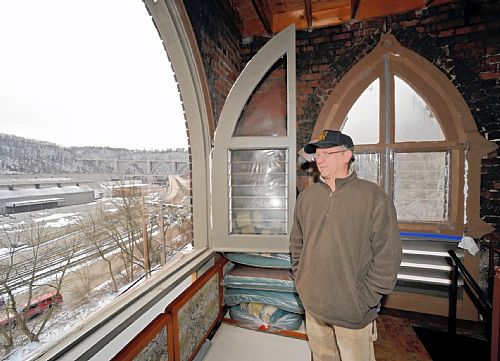
Dan Riccobon converted the bell tower into a small sitting area reached by a spiral stairway that overlooks the former Westinghouse plant. Bob Donaldson / Post-Gazette
In East Pittsburgh, acting as architect, contractor, carpenter and interior designer, Mr. Riccobon has done most of the work himself, from removing the rotting steeple to building the bathroom and kitchen to painting the ceiling of the nave, on his back on a scaffold, with the constellations and the creatures that inspired them.
The result is a sweet, magical, handcrafted space suffused with warmth and a playful spirit of creativity.
“I was giddy when I first moved in,” said Mr. Riccobon, a painter and retired Woodland Hills art teacher.
By then, some of the biggest jobs were behind him, including rewiring the building, vacuuming soot from the attic and insulating it, and installing a shower in the basement.
“It was a long two years traveling back and forth working on the weekends, I can tell you that.”
But what a difference.
For more than 20 years, “I lived in Regent Square in a little tiny third-floor apartment you could hardly stand up in.”
In Westinghouse’s shadowThe congregation that built Emanuel Lutheran Church pretty much lived and died with the Westinghouse plant just across the street.
Westinghouse Electric built its primary plant in East Pittsburgh in the Turtle Creek Valley in 1895, making electric railway motors, generators, switches and other railway equipment. Two years later, German immigrants founded Die Reformations Gemeinde and built a frame church on a narrow, elevated triangle of land on Linden Avenue, then a bustling commercial street.
In 1923, the church was demolished and the triangle leveled to build the new brick church. The congregation sold the building 75 years later, a decade after the Westinghouse plant closed in 1988.
When Mr. Riccobon bought the church, the whole interior was painted white. When some of the paint began to peel, he discovered a decorative border just beneath the ceiling. He made a stencil from the fragment and restored the entire border, along with the church’s ochre-toned walls.
He’s also kept the painted angels-on-canvas that flank the apse, where his 15-foot balsam fir Christmas tree still soars.

The former sanctuary is now a large open living space, with the old altar making home for a huge Christmas tree. Bob Donaldson / Post-Gazette
The nave — the large open area that makes up most of the interior — holds Mr. Riccobon’s living space, with two sitting areas and a dining table near the new kitchen.
Until last June, he used the larger kitchen in the basement but tired of running up and down steps to prepare meals. So he turned the church’s coat closet into his new kitchen, building the Craftsman-style cabinets from scratch using beadboard paneling from Construction Junction. The marble countertops, once part of the wall of a bank, came from CJ, too, as did the Carrara glass back splash.
“It’s a two-way street,” Mr. Riccobon said. “I deliver stuff, too, from here. I’ve taken over doors and sinks I’ve removed.”
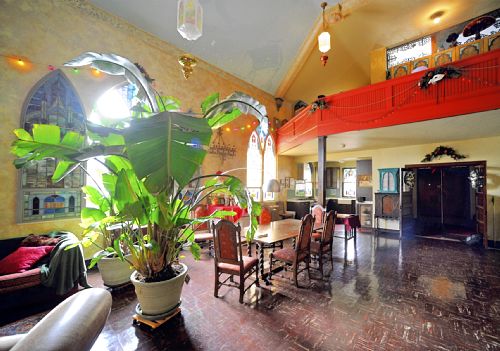
The former sanctuary is now a large open living space, with the kitchen tucked into a corner under the former choir loft. Bob Donaldson / Post-Gazette
At a friend’s urging, he replaced several panes of the stained glass window above the kitchen sink with clear glass. Now he has a view of the Westinghouse Bridge.
Oh gee, what a bathroom!The former choir loft is his bedroom, with a homemade Murphy bed and a wall of IKEA cupboards painted to resemble an old Venetian screen.
But the showstopper is the adjacent tiled bathroom and its ogee-arch shower opening. He made the turquoise tiles that frame it, glazing and firing them along with student work at Woodland Hills High.
The bathroom’s curved wall (and curved interior windows; that was a challenge) was ordained by the circular staircase he installed to get to the bell tower, now a summer sitting area with sweeping views of the valley. Higher still and accessible by ladder is the open deck that held the steeple.
The huge basement houses Mr. Riccobon’s painting studio, where he produces large-scale canvases based on his photographs of Venetian architecture. He uses some of the same techniques as in his decorative painting, creating built-up surfaces with a patina of antiquity.
For a dozen years Mr. Riccobon had a studio in Oakland, where he worked on sets and costumes for the late Don Brockett’s productions. The Jack Lambert head atop the library’s bookshelves is a relic of that era.
He made the big harlequin head mounted on the west wall for a Mardi Gras party he threw in 2000 for the teachers he’d worked with at several Woodland Hills schools. He created the King Kong head and the 11-foot-tall Frankenstein that looms over the library alcove for one of his Halloween parties.
For Mr. Riccobon, the best part of having home and studio in the same building is not the easy commute but having work in progress so close at hand.
There’s an advantage to “being able to look at what you’re working on as you walk by, rather than leaving it and not beginning to think about it until you see it again,” he said. “As an artist, about 80 percent of the work you do is thinking about it, judgmental things, rather than the actual painting.”
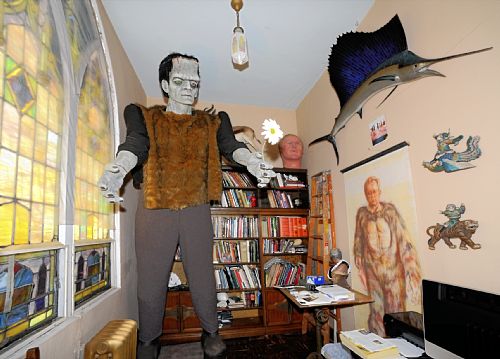
A small room off the former alter is an eclectic mix of his art, including Frankenstein, Jack Lambert's head and a painting of Riccobon in a gorilla suit. Bob Donaldson / Post-Gazette
He has a word of caution for anyone considering buying a church for living space. Before you can bid on the building, he said, you’ll need a mortgage approval, and to get that you’ll need an architect’s renovation drawings and a contractor.
He ended up taking another route, paying with cash socked away during all those years living in the third-floor walk-up. That left him little money for the major renovation he’d been contemplating, but that turned out to be a good thing.
“It allowed me to live here and get a feel for what I needed,” he said. “If I hadn’t, it would have been a disaster. I had thoughts of putting in a second floor.
“What I finally decided I should do is make everything look like it belonged here in the beginning,” he said. “Nothing’s nicer than these giant ceilings.”
-
Carlynton Votes to Consolidate Elementary Schools
Friday, February 18, 2011By Kim LawrenceThe Carlynton school board voted 5-4 Thursday night to close Crafton and Carnegie Elementary Schools and build a new school at the site of the existing Carnegie Elementary School.
The decision came after about two hours of listening to Crafton parents discuss the devastation that would occur if they lost their neighborhood elementary school. Carnegie council members said they would welcome a consolidated school in their neighborhood.
School board President Thomas W. Brown, Vice President Patty Schirripa, Sandra Hughan, Ronald McCartney, and Thomas Di Pietro voted for this consolidation. Board members Nyra Schell, Betsy Tassaro, Sharon Wilson and Raymond Walkowiak dissented. Mr. McCartney made the motion to build a new elementary school at the Carnegie site to accomodate all of the children in the district. Director DiPietro seconded the motion.
The details have yet to emerge regarding where the students will go when their school is torn down. Mr. McCartney said that the Carnegie athletic field would remain intact.
-
Opponents to Closing Pitcairn Elementary School State Case
Thursday, February 17, 2011By Deborah M. Todd, Pittsburgh Post-GazetteUsing a range of emotional and economic arguments, dozens opposed to the proposed closing of Pitcairn Elementary School stated their case Tuesday night during a public hearing hosted by the Gateway School District.
Standing before the school board and other district officials, the majority of speakers testified to the school’s significance to community vitality. Rollo Vecchio, president of Pitcairn council, said a condition of the original merger of the two districts serving Monroeville and Pitcairn in the 1950s was that a school building always remain in Pitcairn.
“It’s part of our community that has served its meaning well and I’m asking you to keep it up … It’s the centerpiece of our community and I hope it can stay that way,” he said.
The school district is considering closing Pitcairn Elementary as part of a realignment plan that could eliminate all elementary buildings in favor of a new K-4 building on the Gateway Campus.
Mr. Vecchio dismissed a finding by consulting firm Education Management Group LLC that the school faces threat of flooding from Dirty Camp Creek, stating that a project redirecting the stream is nearly 90 percent complete.
Many more speakers rejected aspects of the report, including no mention of how much money the district would save through the closure and a lack of plans to close any elementary school other than Pitcairn.
“There has been no positive plan for maintaining Pitcairn Elementary School presented by the school board. Overall, the conclusions of EMG were always prejudiced and slanted, targeting Pitcairn Elementary School time and time again for closure,” said Betsy Stevick, president of the Pitcairn High School Alumni Association.
Some speakers offered alternatives to the plan to consolidate schools. Speaker Fred Mendicina suggested closing University Park Elementary and distributing its students throughout the remaining schools to increase all of the buildings’ enrollment. Speaker Leeann Pruss suggested the district extend elementary schools to fifth grade and merge schools for grades 6-8.
“It would solve the issues of those wanting more students on Gateway Campus, it would give you [Gateway Middle School] located near the parkway and turnpike that could potentially sell for a lot more than Pitcairn Elementary, it would eliminate a transition for all students instead of increasing transitions for Pitcairn students, and it gives you a lot more future benefits than closing one elementary and leaving all others operating under capacity,” she said.
District officials declined comment following the meeting, but some of those who attended said they were encouraged by board members’ actions during the meeting.
“We don’t know, but it looked like they were paying attention,” Ms. Pruss said.
“They’re going to have to go home and digest the information,” Ms. Stevick said.
Either way, Ms. Pruss said, this isn’t the last the board has heard from them.
“They have 90 days, we’re not going to leave them alone, we’re not going to let it drop,” she said.
-
County Urban Farm Effort Expands in Second Year
‘Allegheny Grows’ will donate produce to food pantries, families in needThursday, February 17, 2011By Len Barcousky, Pittsburgh Post-GazetteA new “urban farm” in Bellevue will help North Hills Community Outreach achieve one of its top goals for the more than 1,200 families it serves each year.
The fresh tomatoes, peppers and beans raised there this summer will aid the social service agency in assuring “adequate healthy nourishment for the people who use our food pantries,” executive director Fay Morgan said.
Bellevue’s new garden will be part of the second year “Allegheny Grows” urban-agriculture effort. Bellevue, Wilkinsburg and Penn Hills were selected last week to participate in the expansion of the program.
Their projects were selected from among proposals submitted by a dozen municipalities and their local partners.
The community gardens and urban farms that Allegheny Grows sponsors offer environmental, economic, social and educational benefits, project manager Iris Whitworth said. She works for the county’s economic development office.
Communities and projects were picked based on strong municipal leadership, enthusiasm of local volunteers, suitability of their garden site and community need, Ms. Whitworth said.
The effort has the support of County Executive Dan Onorato. “Allegheny Grows builds on the county’s ongoing initiatives to revitalize older communities and distressed municipalities through sustainable development and strategic investment,” he said in a statement.
This year’s budget for Allegheny Grows is about $75,000. In addition to setting up new projects in the three communities, the funds will be used to cover second-year costs for garden projects begun last year in Millvale and McKees Rocks.
Gardeners in both communities will get seedlings and technical advice. Millvale’s project also will receive rain-collecting barrels, and McKees Rocks will get help in edging its garden beds and making them accessible to people with disabilities.
The money for Allegheny Grows comes from federal community development block grants.
Local partners in each community will work with “Grow Pittsburgh,” which was formed in 2005 to encourage city gardening, and with the Western Pennsylvania Conservancy. The Western Pennsylvania Conservancy is well known for its summer flower gardens. Working with various partners, it plants 140 of those in 20 counties.
The organization also has been long involved in support for vegetable gardening, Judy Wagner said. She is the director of the conservancy’s community gardens and greenspace programs. Its community garden projects were common in the 1980s as the region’s steel industry collapsed, she said. Many families turned to growing food for themselves and their neighbors.
More than a year ago, the conservancy and Grow Pittsburgh teamed up to teach people how to grow food in urban setting.
Conservancy staff will work on design and construction at all three sites while Grow Pittsburgh will take lead in training volunteers.
BellevueBellevue’s project will be on Davis Avenue on a 13,500-square-foot tract owned by North Hills Community Outreach. The land had been donated in 2008 by Terrie Amelio, of McCandless, to the social-service agency. The site will be named the Rosalinda Sirianni Memorial Garden in honor of Mrs. Amelio’s mother, Ms. Morgan said.
Most of the labor for the organic farming effort will be provided by volunteers, who will be supervised by a part-time community outreach employee, Ms. Morgan said. Produce grown there will be donated to food pantries.
Bellevue will supply water for the garden, and two foundations are among those aiding the effort. The Comcast Foundation will provide funds to hire the part-time coordinator, and the Grable Foundation has given money to pay local youth helpers to work with the volunteers.
WilkinsburgWilkinsburg’s urban farm will be part of a 2-acre site on Jeanette Street in the city’s Hamnett Place neighborhood. The land is owned by Pittsburgh History and Landmarks Foundation, which already is involved with several housing renewal projects in the community. Allegheny Grows will be working with a citizens organization called Hamnett Place Community Garden Association to plant and care for the site.
The site will have 16 individual plots and can be expanded to more than 20, garden association president Rachel Courtney said. Another portion of the vacant lot will be converted into a play-and-learning area for neighborhood children.
Local residents are already planning their own plots. “A woman from Jamaica has told us she hopes to grow things that she can’t find in the grocery stores here,” Ms. Courtney said.
“Buildings are not what make communities,” Karamagi Rujumba said. “People make communities.”
That is why his employer, the Pittsburgh History and Landmarks Foundation, is assisting in the Allegheny Grows effort, he said. Mr. Rujumba is coordinator of landmarks foundation programs in Wilkinsburg.
The garden and adjoining children’s “learning space” should teach people practical gardening skills and give them a sense of ownership in their community, he said.
The Hamnett Place project also has received funding from the Heinz Endowment, the Richard Mellon Scaife Foundation, Allegheny County and the state.
Penn HillsPenn Hills will provide water and leaf-mulch compost for an expanded community garden that occupies the site of a former municipal ballfield in the 1100 block of Jefferson Road.
Local Boy Scouts last year helped to clear and prepare the site for gardening as an Eagle Scout project, Ed Zullo, president of Penn Hills Community Development Corp., said.
The site had been divided into a dozen raised garden beds, and plans for this spring call for almost doubling that number to 22 plots.
Gardeners last year raised vegetables both for their families and donated baskets of tomatoes and peppers to two local food pantries, Mr. Zullo said. That effort likely will expand to benefit a third pantry this year.
His agency’s partnership with Allegheny Grows could mark the start of efforts to create additional agricultural sites across Penn Hills, he said.
Community gardens offer multiple benefits, supporters say. They provide fresh, healthy food and they can improve the appearance of blighted land. Their vegetation helps to reduce storm-water run-off, and the flowering plants growing there help support bee colonies and other pollinators.
They also have less obvious advantages. “Neighbors in Millvale really enjoy working together,” the conservancy’s Ms. Wagner said. “You are growing your community as you are growing vegetables.”
Mr. Zullo agreed that gardens can serve as a development tool. “We get neighbors of different generations and different races interacting,” he said. “Old people teach young people, and neighbors compete over who has grown better tomatoes.”

